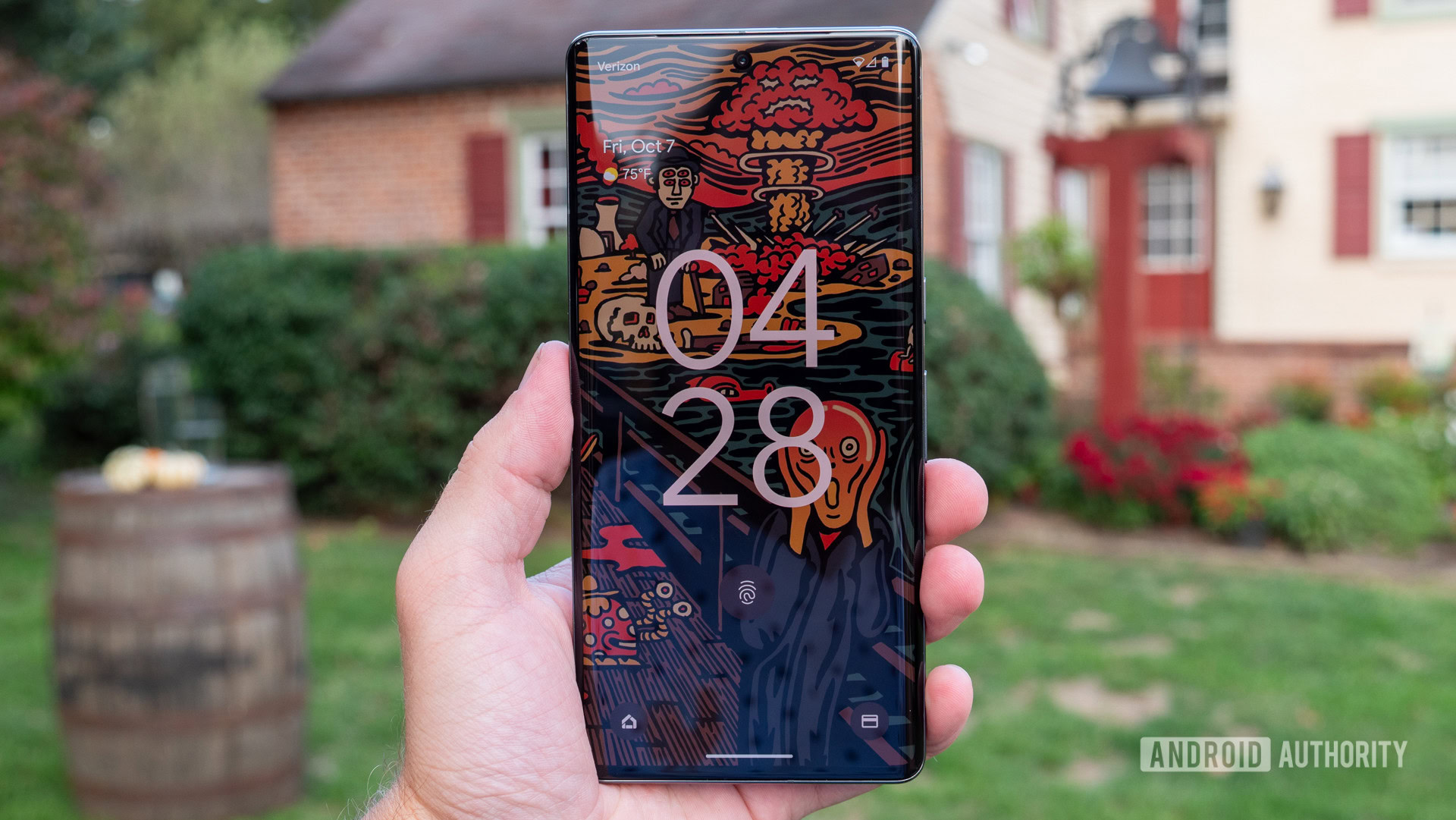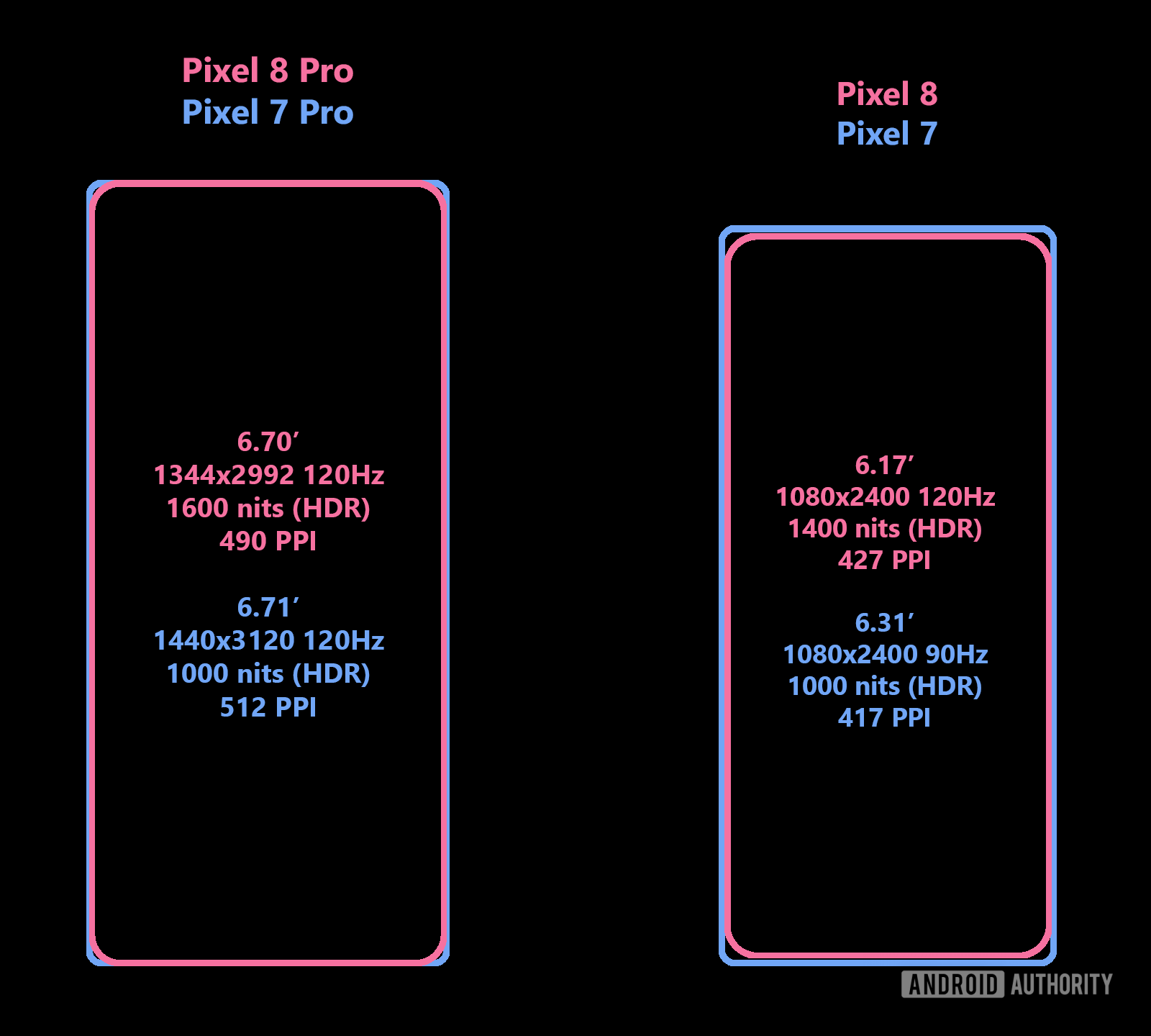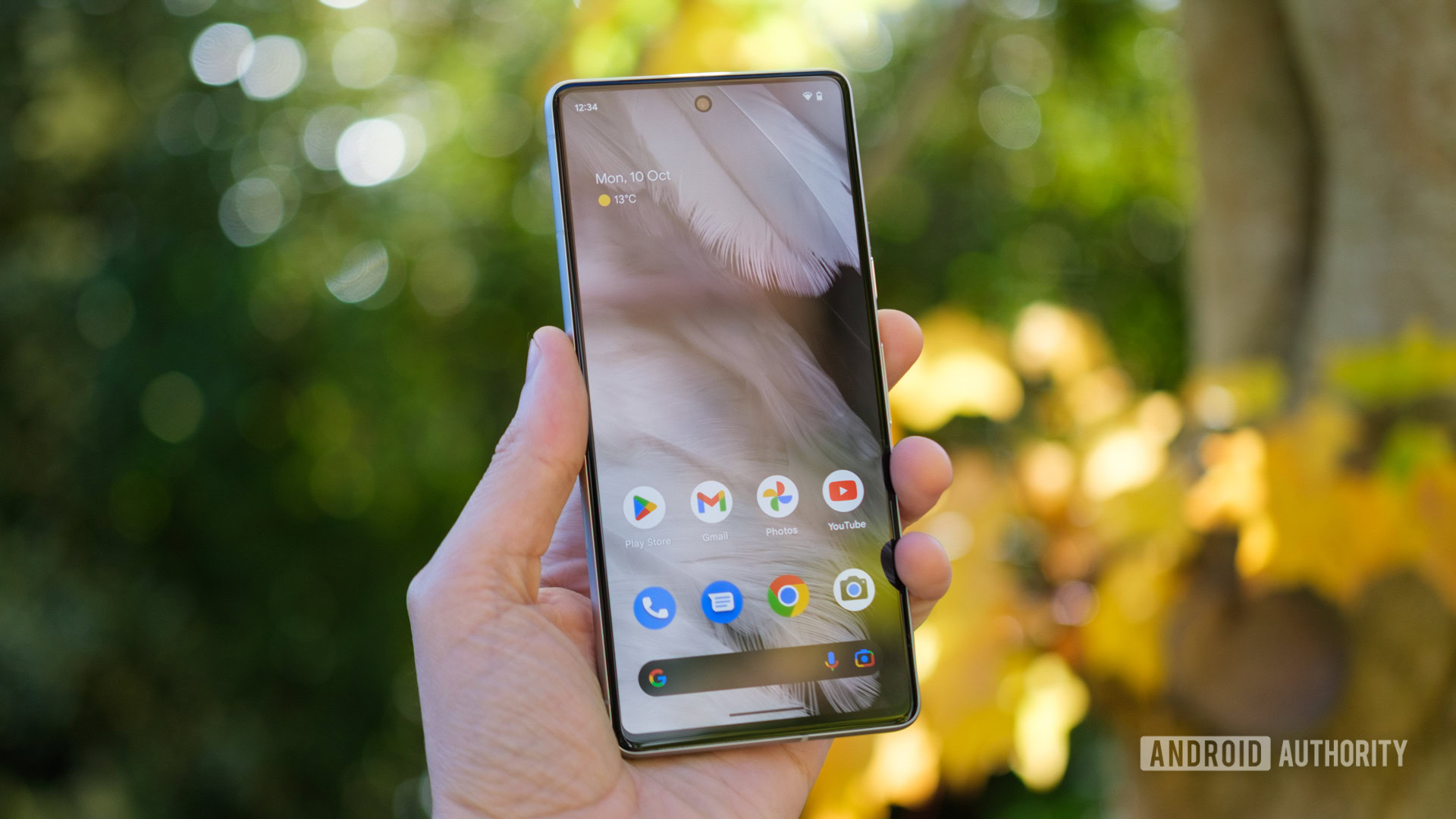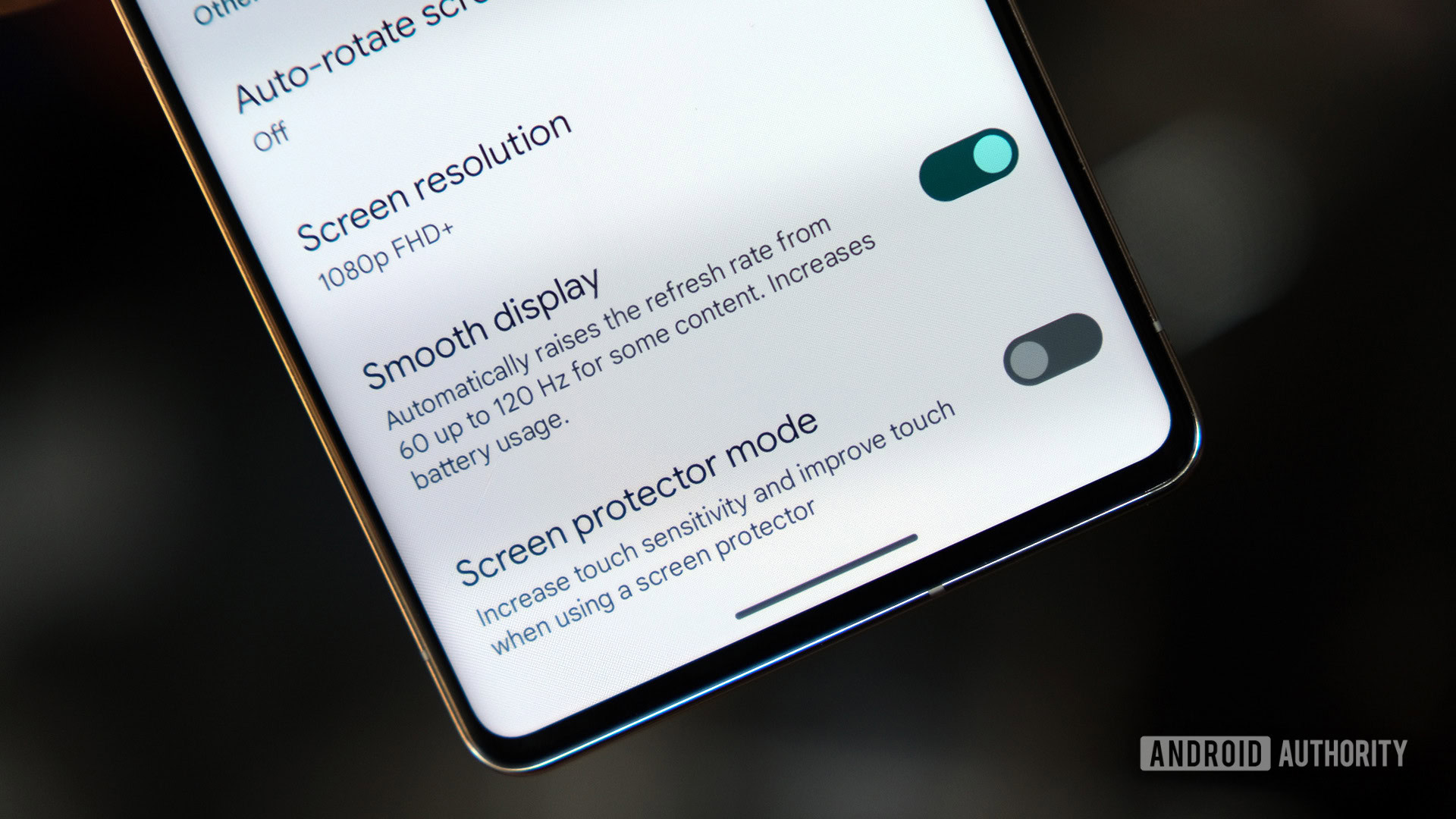Affiliate links on Android Authority may earn us a commission. Learn more.
Exclusive: These are the Google Pixel 8 display specs

It takes a great display to make a brilliant smartphone. Google’s most recent Pixel phones have been good in this regard, especially in realistic color reproduction. However, they’ve never quite matched the very best in some important areas, such as peak brightness and dynamic refresh rates. Google has frequently used older generation panels, presumably to save some money to position their offerings more aggressively. The downside is that its last flagship, the Pixel 7 Pro, while well-calibrated, was just not bright enough in some scenarios.
Thanks to a source inside Google, we’ve gained a lot of insight into the display specs and features of the upcoming Google Pixel 8 series, and a lot looks set to change.
Finally, flat edges for the Pixel 8 Pro

The perfect phone size has been an ongoing debate for years, and it doesn’t seem likely to end anytime soon. Regardless of your opinion on the subject, Google’s Pixel series offers two distinct display sizes — a smaller one on the non-Pro models (6.3-inch on the Pixel 6 and 7) and a larger, curved one on the Pro models (6.7-inch on 6 Pro and 7 Pro). While other specs of the phones aren’t exactly identical, it still gave users a choice.
With the Pixel 8 series, Google is tweaking the formula a bit. Firstly, the regular Pixel 8 is moving to a smaller display — 6.17-inch instead of the 6.3-inch on previous models. The Pixel 8 Pro, on the other hand, retains the same 6.7-inch size, but the panel is now flat — good news for the many people who consider flat displays to be a positive thing.
Google has also fine-tuned the rounded corners of both models, more than doubling the corner radius in both cases. In other words, the displays are slightly less square than before and a little more rounded in the corners.
| Pixel 7 | Pixel 7 Pro | Pixel 8 | Pixel 8 Pro | |
|---|---|---|---|---|
Display edges | Pixel 7 Flat | Pixel 7 Pro Curved | Pixel 8 Flat | Pixel 8 Pro Flat |
Screen size | Pixel 7 6.3-inch 66x146mm | Pixel 7 Pro 6.7-inch 71x155mm | Pixel 8 6.17-inch 64x143mm | Pixel 8 Pro 6.7-inch 70x155mm |
Corner radius (at native resolution) | Pixel 7 47px | Pixel 7 Pro 50px | Pixel 8 102px | Pixel 8 Pro 115px |
Brighter displays for HDR

Google has always used OLED displays for Pixels, and it’s no different this time around. What might be changing, however, is the source of the panels. The last couple of Pixel generations exclusively used panels from Samsung. The exception was a mysterious, unreleased device codenamed G10, which would have a BOE display instead. I speculated at the time of the initial reports that Google was testing the panel to evaluate whether BOE was reliable enough to be included in Pixel phones, and it now turns out it was true. While the larger Pixel 8 Pro has a panel from Samsung, just like the previous generations, the regular Pixel 8 has two sources for the panel: BOE and Samsung. My source couldn’t confirm whether Google will use both in the production process or if this was simply an early evaluation, but both panels share the same specs, which could suggest the former.
This Pixel generation also changes the resolution of the Pro phone for the first time since the Pixel 6 series. Google has opted for a slightly smaller 2,992 x 1,344 resolution for the Pixel 8 Pro instead of the old 3,120 x 1,440 standard, giving it a pixel-per-inch (PPI) density of 490, down from 512.
The resolution of the Pixel 8 remains unchanged, which, combined with the smaller display, means its PPI is slightly higher: 427 instead of 417.
| Pixel 7 | Pixel 7 Pro | Pixel 8 | Pixel 8 Pro | |
|---|---|---|---|---|
Resolution | Pixel 7 2,400 x 1,080 | Pixel 7 Pro 3,120 x 1,440 | Pixel 8 2,400 x 1,080 | Pixel 8 Pro 2,992 x 1,344 |
PPI | Pixel 7 417 | Pixel 7 Pro 512 | Pixel 8 427 | Pixel 8 Pro 490 |
Brightness (HDR, declared NOT measured) | Pixel 7 1,000 nits | Pixel 7 Pro 1,000 nits | Pixel 8 1,400 nits | Pixel 8 Pro 1,600 nits |
The brightness of both of the phones has also been substantially improved, at least according to the values declared in code (which, keep in mind, can differ from reality). The Pixel 8 can supposedly achieve up to 1,400 nits peak brightness in HDR content, up from 1,000 nits on the Pixel 7. The Pixel 8 Pro has also been upgraded and can now display up to 1,600 nits in HDR, up from 1,000 nits on the 7 Pro.
An enhanced variable refresh rate for the Pixel 8 Pro

Since the Pixel 6 series, Google has used display refresh rate as a differentiator between different product tiers. For example, in the Pixel 6 series, the Pixel 6a was 60Hz, the Pixel 6 was 90 Hz, and the Pixel 6 Pro had 120Hz.
The Pixel 7 series made a significant adjustment — the Pixel 7a now has a 90Hz panel to match the Pixel 7. This was an interesting move; what was previously the prime reason to pay more for the base phone over the Pixel A series unit was now gone.
However, Google will rewiden that gap between the Pixel 7a and the Pixel 8 series, as the regular Pixel 8 now gets a 120Hz display.
The Pixel 8 Pro also has a notable upgrade of its own; a more variable refresh rate. My source’s information on the topic was limited. Still, it appears that the Pixel 8 Pro will be able to smoothly change the refresh rate between 60 and 120Hz, unlike the previous generations, which could only use a few predefined rates (as listed in the table below).
| Pixel 7a | Pixel 7 | Pixel 7 Pro | Pixel 8 | Pixel 8 Pro | |
|---|---|---|---|---|---|
Maximum refresh rate | Pixel 7a 90 Hz | Pixel 7 90 Hz | Pixel 7 Pro 120 Hz | Pixel 8 120 Hz | Pixel 8 Pro 120 Hz |
Supported modes | Pixel 7a 30 Hz, 60 Hz, 90 Hz | Pixel 7 30 Hz, 60 Hz, 90 Hz | Pixel 7 Pro 30 Hz, 60 Hz, 120 Hz | Pixel 8 10 Hz, 30 Hz, 60 Hz, 120 Hz | Pixel 8 Pro 5 Hz, 10 Hz, 30 Hz, 60-120Hz |
The benefit of this approach is that the display refresh rate can more accurately match different content, reducing screen tearing. For example, 24fps content could now be shown at 72Hz, meaning each video frame is shown for precisely three display refresh cycles (rather than five at 120Hz). Another way this could be utilized is for games. If Google implements this functionality, the display could match a game’s higher frame rates, completely removing tearing, similar to AMD’s FreeSync or Qualcomm’s Q-SYNC. Also, the new displays clock down to as low as 5Hz, saving power when the screen is not actively refreshing content.
That’s everything there is to know about the display on the Pixel 8 series. It appears that Google’s upping its game to compete with the very best in yet another aspect. So far, all the Pixel 8 leaks suggest the phones will be a huge improvement, and the display is no different. I can’t wait to upgrade to the Pixel 8 Pro when it comes out.